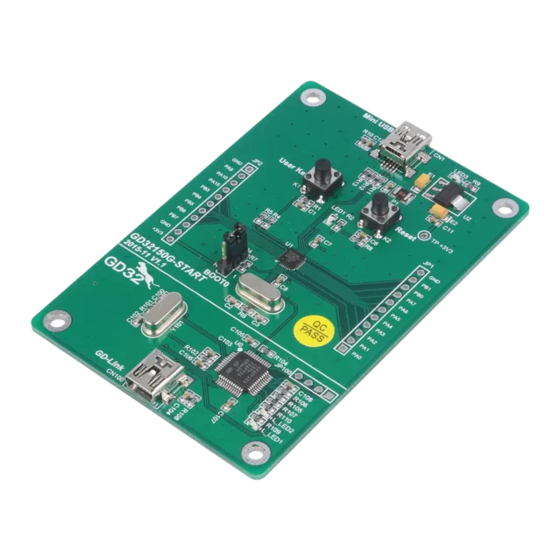
Table of Contents
Advertisement
Quick Links
Advertisement
Table of Contents

Summary of Contents for GigaDevice Semiconductor GD32150G-START
- Page 1 GigaDevice Semiconductor Inc. GD32150G-START User Guide V3.0 (Nov.20.2019)
-
Page 2: Table Of Contents
User Guide GD32150G-START Table of Contents Table of Contents ..........................1 List of Figures ............................. 2 List of Tables ............................3 Summary ............................4 Function Pin Assign ........................4 Getting started ..........................4 Hardware layout overview ......................5 4.1. Power supply ........................5 4.2. -
Page 3: List Of Figures
User Guide GD32150G-START List of Figures Figure 4-1 Schematic diagram of power supply ....................5 Figure 4-2 Schematic diagram of boot option ....................5 Figure 4-3 Schematic diagram of LED function ....................5 Figure 4-4 Schematic diagram of Key function ....................6 Figure 4-5 Schematic diagram of USB function .................... -
Page 4: List Of Tables
User Guide GD32150G-START List of Tables Table 2-1 Pin assignment ............................4 Table 4-1 Boot configuration ..........................5 Table 6-1 Revision history ............................. 11 3 /12... -
Page 5: Summary
User Guide GD32150G-START Summary GD32150G-START-V1.1 board uses GD32F150G8U6 as the main controller. As a complete development platform of GD32F1x0 powered by ARM® Cortex™-M3 core, the board supports full range of peripherals. It uses mini-USB interface to supply 3.3V power. SWD, Reset, Boot, User button key, LED and Extension Pin are also included. -
Page 6: Hardware Layout Overview
User Guide GD32150G-START associated files. Hardware layout overview 4.1. Power supply Figure 4-1 Schematic diagram of power supply 4.2. Boot option Figure 4-2 Schematic diagram of boot option Table 4-1 Boot configuration BOOT1 BOOT0 Boot Mode User memory Default System memory... -
Page 7: Key
User Guide GD32150G-START 4.4. Figure 4-4 Schematic diagram of Key function +3V3 10KΩ K-1102B 50V/0.1uF 4.5. Figure 4-5 Schematic diagram of USB function 6 /12... -
Page 8: Gd-Link
User Guide GD32150G-START 4.6. GD-Link Figure 4-6 Schematic diagram of GD-Link function MCU SWD PA0-WKUP R103 +3V3 JP100 PB2/BOOT1 PB3/JTDO 10KΩ L_SWDIO L_TMS/IO PB4/JNTRST L_SWDCK L_TCK/CLK L_TDO/SWO L_TDI 4× 1P2.54 L_USB_Ctr L_TReset L_LED1 LED0603 PA10 PB10 L_USB_DM PA11 PB11 L_USB_DP... -
Page 9: Mcu
Learn to use GPIO for controlling the LED Learn to use SysTick to generate 1ms delay GD32150G-START-V1.1 board has one LED. The LED1 is controlled by GPIO. This demo will show how to light the LED. 5.1.2. DEMO running Result Download the program <01_GPIO_Running_LED>... -
Page 10: Demo Running Result
Learn to use SysTick to generate 1ms delay GD32150G-START-V1.1 board has two keys and one LED. The two keys are Reset key and User key. The LED1 is controlled by GPIO. This demo will show how to use the User key to control the LED1. When press down the User Key, it will check the input value of the IO port. -
Page 11: Demo Running Result
User Guide GD32150G-START GD32150G-START-V1.1 board has two keys and LED1. The two keys are Reset key and User key. In this demo, the START board is enumerated as an USB Keyboard, which uses the native PC Host HID driver, as shown below. The USB Keyboard uses user key to output one characters ‘a’. -
Page 12: Revision History
User Guide GD32150G-START Revision history Table 6-1 Revision history Revision No. Description Date Initial Release Jun.28, 2017 Updated format across the whole document Jun.1, 2019 Updated format across the whole document Nov.20, 2019 11 /12... - Page 13 Important Notice This document is the property of GigaDevice Semiconductor Inc. and its subsidiaries (the "Company"). This document, including any product of the Company described in this document (the “Product”), is owned by the Company under the intellectual property laws and treaties of the People’s Republic of China and other jurisdictions worldwide.

Need help?
Do you have a question about the GD32150G-START and is the answer not in the manual?
Questions and answers